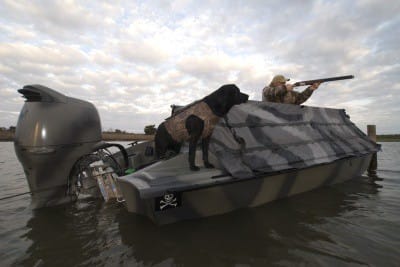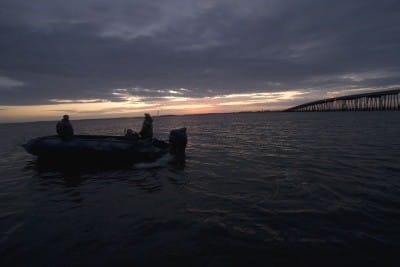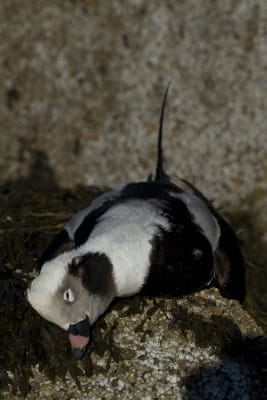 The wind was howling and the waves were breaking at an honest four feet. At 100 yards I could see low flying scoters appear and disappear between the rows of swells when my guide Jeff Coats yelled, ” They’re coming right in!”
The wind was howling and the waves were breaking at an honest four feet. At 100 yards I could see low flying scoters appear and disappear between the rows of swells when my guide Jeff Coats yelled, ” They’re coming right in!”
The large black ducks appeared over the waves cupping their wings and turning sharply into the decoys. The moment I fired, the boat pitched down, sending my load of No. 4 Remington shot in an impressive circle around Coats’ hand-carved cork scoter decoy. The two scoters tipped their wings and were out of range in an instant.
I was relieved to hear laughter from the stern of the boat instead of a growl of disgust from Coats. I thought he took the event pretty well considering that I just hammered a $200 decoy. “See? I told you shooting out of a pitching boat is tricky. Ah, don’t worry about the deke, it happens… but… don’t do it again,” he grinned.
Although I’d logged more than 25 years of duck hunting, I had never tasted the spray of salt from a waterfowl boat. Like any avid hunter, I had read my fair share of stories of hunting oldsquaw, brant and eider on the East Coast.
My hunt was scheduled through my long time buddy, Tommy Akin, with Avery Outdoors. Tommy called and invited me to a three-day hunt on the eastern shore. What was I supposed to say… no? Tommy set me up with their Pro Staffer, renowned Maryland waterfowler, Jeff Coats, of Pitboss Outfitters.
A full-time waterfowl guide, in the off-season Jeff carves decoys, edits waterfowl DVDs and trains dogs. He specializes in open ocean waterfowling in the historic Chesapeake Bay area out of Ocean City, Maryland. He is considered by many pros in the waterfowl industry to be one of the most knowledgeable sea guides in the country. One of Jeff’s closest friends and Avery Pro Staffer, Wayne Radcliff, also joined me.
My mid-December arrival found the weather on the balmy side with a steady rain forecasted for most of my two-day hunt. Dependent on weather, cold and ice are what locals hope for and rain is considered not ideal.
Our first morning chasing brant geese we got a break in the rain with near freezing temperatures. Our destination was just off the Chincoteague Island Sanctuary, famous for the roaming bands of small ponies and sitka deer herds.

After anchoring our large boat 50 yards from shore and raising a simple grey skirt for camo, I felt like we needed to move the boat to the bank and cut some grass. Jeff looked at me and said, “You feel a little naked out here, don’t you?” he smiled. With an overly polite tone I responded, “We’re going kill brants out in the open, with 20 silhouette v-boards and two dozen floating decoys?”
With that comment, a group 20 of brants appeared nearly a mile up wind following the channel. As they got closer and with some calling they veered purposely toward the decoys. Guns discharged and brants fell like rain. Coats’ 8-year-old lab “Coot” hit the water churning like an outboard and picked up the four brants that the three of us downed.
Radcliff, a well respected Maryland goose caller, looked at me said, “I love to watch you puddle hunters look in total amazement watching these sea birds work to an un-grassed boat in the open water.”
Most sea ducks live 10 to 20 years, that’s long enough to have lots of hunting history. This obviously makes them more sensitive to hunting pressure. The dichotomy of their age to their experience is that if conditions are right many sea ducks decoy with ease. Making a single flight commitment, they rarely return or circle. So be ready… you almost never get more than one shot.
One of the most rewarding aspects of hunting with Coats is not only his vast experience as a waterfowler, but his personal demeanor.
“Sea ducking hunting is a social sport. We spend the morning in a comfortable boat doing a type of waterfowling that requires fast leading shots. Low flying birds that appear from the ocean offer a visual that is completely alien from most inland blind or boat hunts,” Coats said.
With a good of day brants behind us, my last morning found us at an open ocean launch ramp with a steady 20 knot wind and three to four foot rollers out past the shore. The temperature was about 35 with a constant rain. Jeff looked at me and said, “This is the kind of day you came for. Without this boat we would never leave the dock.”

After 15 minutes we set decoys and hunkered down below the canvas and watched the scoters and oldsquaws fly out of the mist to bomb the decoys.
Classic sea duck hunting is fast and low to water. Scoters and old squaws can fly right off the surface of the water at 50 mph forcing the kind of shot that you never seem to catch up with. You spend your first hour learning how to lead a duck at crazy lengths. Once you finally catch up with the bird and roll them into the water you must follow with the cardinal rule of sea duck hunting … shoot them again.
I had an oldsquaw hit the water so hard he rolled three times landing with his head in the water. The drake bobbed in and out of the water for an entire minute, but as soon as the dog got close, he raised his head up and flew away as if he didn’t have a scratch. And if they don’t fly away, they’ll dive. We hit one that was never seen again. So even if they look out of commission, give them another round.
Our morning literally blew by with two hours of shooting and a notable amount of misses. Although the three of us didn’t quite make our limit, the forceful winds and tough dog conditions sent us back to dinner for a hot meal.
Among the lessons learned over this hunt were lead the duck, and then lead him some more, and squat (don’t sit) over the bucket and you’ll have far fewer misses.
In many facets, other than pulling the trigger, sea duck hunting shares little resemblance to puddle duck hunting.
The Eastern experience is steeped in traditions like cork decoys, floating silhouettes and large birds that often don’t look or fly like mallards, widgeons and gadwalls. It was just what I longed for – great company, completely different gear, and humbling shooting.



